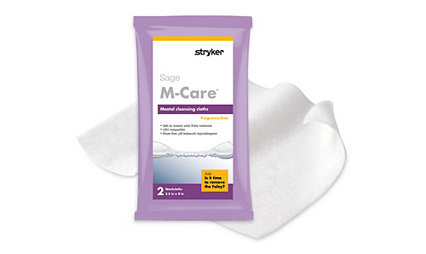Reduce the risk of catheter-associated urinary tract infection (CAUTI) in hospitals
28-Mar-2024

3-minute read
Healthcare-associated infections (HAIs) are one of the most common complications of hospital care. These infections cost U.S. hospitals billions of dollars each year. Catheter-associated urinary tract infections (CAUTIs) are among the most common types of healthcare-associated infections. Complications associated with CAUTI included increased length of stay, increased mortality and cost U.S. hospitals an estimated $340-$450 million per year.1 Given these outcomes, understanding and reducing the risk of CAUTI is an important part of patient care.
What is CAUTI?
CAUTI occurs when bacteria or other germs enter the urinary tract through a urinary catheter, causing an infection. CAUTIs can affect any part of the urinary system, including the urethra, bladder, ureters and kidneys.2
Advocating for change
As the primary point of care, nurses play an instrumental role in reducing the risk of CAUTI. Their roles and responsibilities allow them to advocate for preventive strategies. These measures can encompass a wide range of practices, from monitoring catheter insertion to helping change protocol to include external urine management options.
Proactive steps to reduce the risk of CAUTI
- Adherence to sterile insertion practices: Ensuring aseptic techniques during catheter insertion is critical. This involves using sterile gloves, drapes, sponges and an appropriate antiseptic for periurethral cleaning.
- Judicious use of catheters: Avoid unnecessary catheterization and remove catheters as soon as clinically possible. Implementing nurse-driven protocols for catheter removal can significantly reduce the duration of catheterization and the risk of CAUTI.
- Utilization of external urinary catheters: Where feasible in accordance with hospital protocols, opt for external catheters. These reduce the risk of infection significantly compared to indwelling urinary catheters. External urine management devices, like PrimaFit and PrimoFit+, are especially useful for certain patient populations.
- Routine catheter care: Regularly inspect catheters and the area around the urethral opening. Ensure the catheter is securely placed to avoid movement and trauma.
- Infection control measures: Regular hand hygiene, use of personal protective equipment and a clean environment are essential to prevent cross-contamination.
Connect with Stryker for advanced solutions
At Stryker, we’re dedicated to providing innovative medical solutions to enhance patient care. Our external urinary management devices are designed with the patient's safety and comfort in mind. We invite healthcare professionals to connect with us for more information and guidance on reducing risk factors for effective CAUTI prevention strategies. Together, we can make a significant difference in patient care and outcomes.
FAQs about CAUTI and prevention
- What is CAUTI and why is it a concern? CAUTI is an infection that occurs in individuals using a urinary catheter. It can be acquired by unnecessary use, poor insertion technique that can introduce bacteria, and leaving a catheter in too long allowing bacteria to travel up the catheter. The resulting infections can cause serious health complications including sepsis.3
- How does external urinary management help in preventing CAUTI? External urine management devices do not enter the urinary tract, thereby significantly reducing the risk of urinary tract infections.
- Can CAUTI be entirely prevented? While not all CAUTIs can be prevented, adherence to best practices and guidelines can help reduces the risk factors that contribute to their incidence.
- Is patient education important in CAUTI prevention? Absolutely. Educating patients about the signs of infection can aid in early detection and prevention.
Learn more about CAUTI
Sage PrimaFit External Urine Management System for the Female Anatomy helped reduce CAUTI rate 63%
Catheter-related infections decreased from before the introduction to EUDFA and after. This is not a cause-and-effect relationship, but the trend is promising.
Learn moreNYC Medical Center Implementation of External Female Catheter avoids $16M in costs over 2 years
In 2018, the implementation of the external female urine management device was introduced as a standard of nursing care as an alternative to an indwelling urinary catheter. Data captured in 2019 and 2020 showed utilization of the external female device to be 36% and 46%, respectively.
Learn moreFeatured products
Sage PrimaFit External Urine Management for the Female Anatomy
PrimaFit is designed to bend, fit and stay in place. It’s customizable so you can find a comfortable curve to fit your patients.
Learn moreSage PrimoFit+ External Urine Management for the Male Anatomy
PrimoFit+ external urine management is designed to provide an easily customizable fit that stays in place to effectively manage urinary incontinence and keep patients comfortable.
Learn moreSage M-Care Meatal Cleansing Cloth
M-Care meatal cleansing cloths provide a clean technique for your Foley-catheterized patient.
Learn more1. Agency for Healthcare Research and Quality (AHRQ), Toolkit for Reducing Catheter-Associated Urinary Tract Infections in Hospital Units: Implementation Guide, Rockville, MD. Content last reviewed October, 2015.
2. Centers for Disease Control and Prevention, Catheter-associated Urinary Tract Infections (CAUTI), page last updated July 19, 2017.
3. Atkins L, Sallis A, Chadbom T, et al. Reducing catheter-associated urinary tract infections: a systemic review of barriers and facilitators and strategic behavioural analysis of interventions, Implementation Science, 2020;15:44.
SAGE-UM-COMM-1011497_REV-0_en_us






